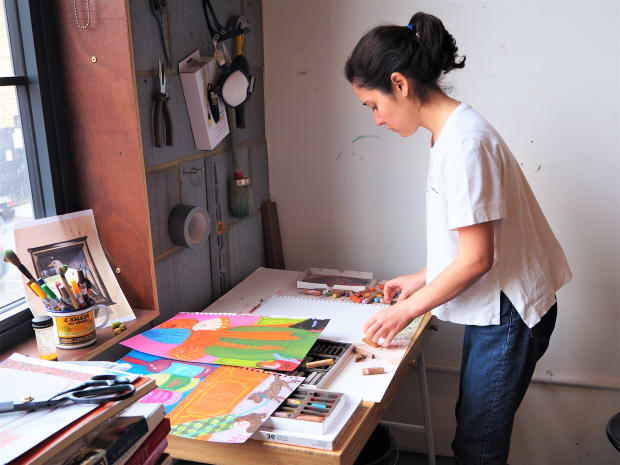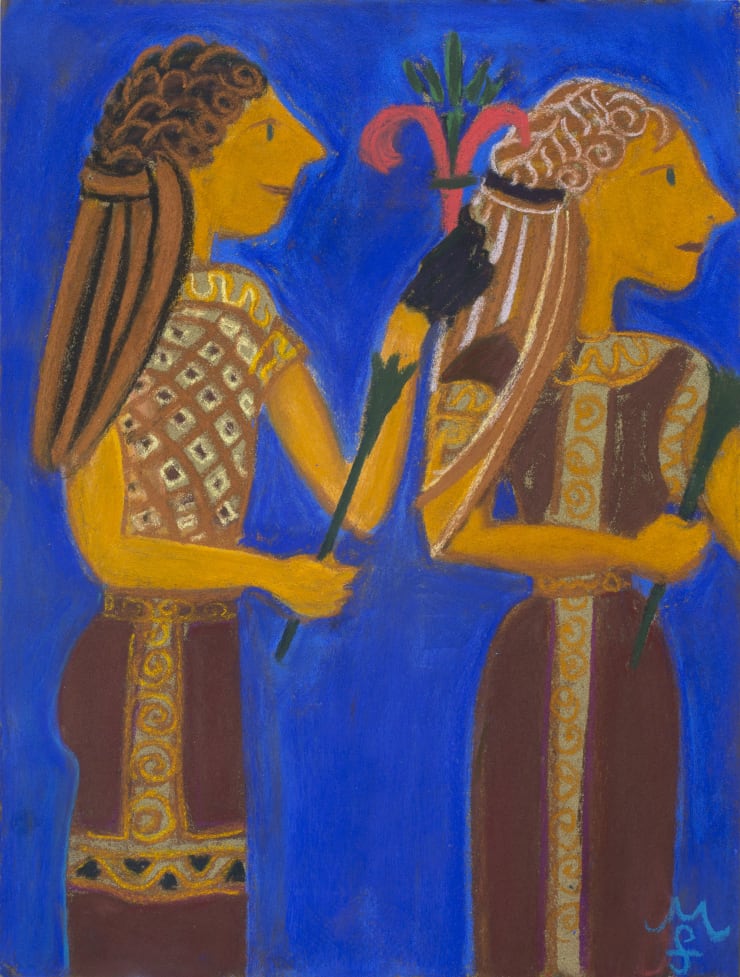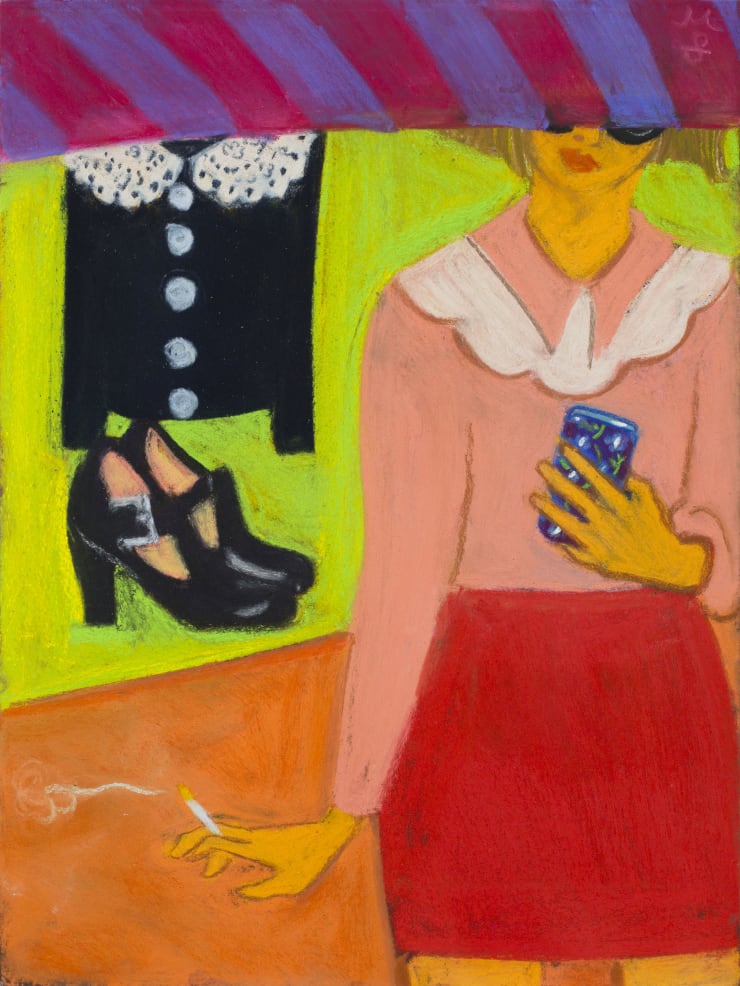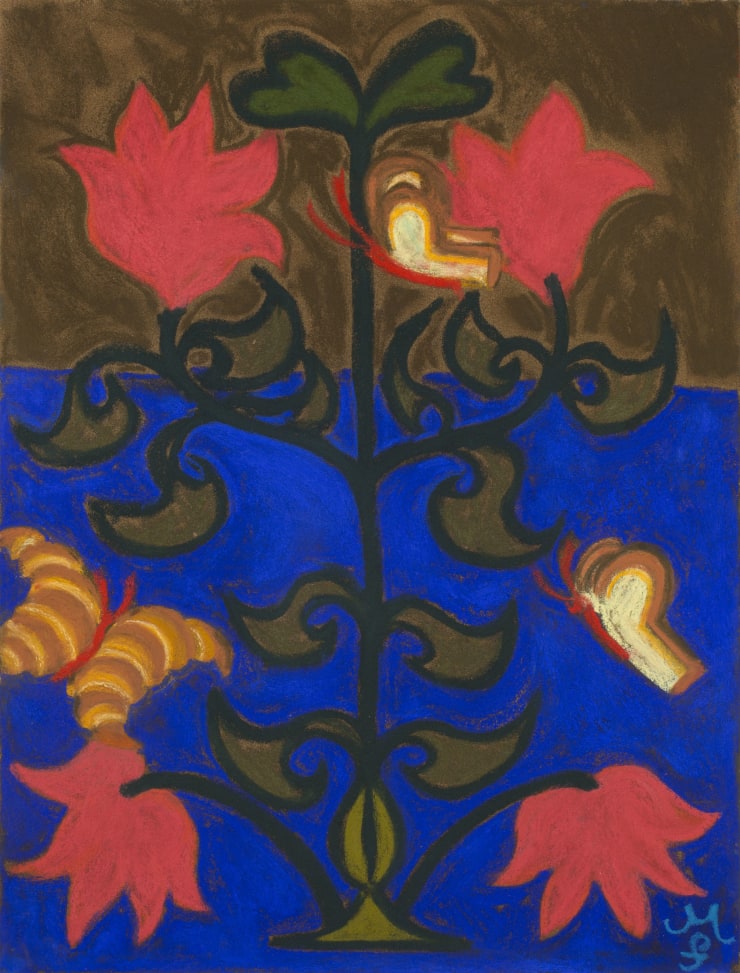-
-
Maria Farrar paints scenes derived from her everyday life or from fragments of memories. The captured moments are concrete and yet at the same time, they contain a sense of elusiveness and the feeling of a floating and expanding world. In her earlier paintings, thick sweeping strokes outlined a person's silhouette against the raw linen support, reminiscent of East Asian calligraphy with its smudges and dry brush, which she cultivated while growing up in Japan.
Farrar’s recent works reflect her new exploration and painting style – the increasing layers of colours start to cover the entire picture plane, introducing a rich, vibrant background that sets the tone for her narratives. She remarks on this as the idea of coming and going between the East and the West in terms of technique, colour, narrative and reality. We had a chat with the artist to find out more about what she has been working on recently.
-

Maria Farrar working in her studio, 2020 © Maria Farrar, Courtesy of the Artist
-
O: With the Covid-19 pandemic in session, did you make any changes to your practice to adapt to the new normal?
M: When I couldn't go to my studio, I made a series of small drawings that were manageable from home. I had forgotten how much I loved pastels, their ease and pure colour. Some of these drawings became the composition for the largest pictures. I had always liked the idea of planning paintings but as none of them went according to plan, I had given up on planning. This time, the pastel naturally became a smaller model for a larger piece.
I think the pandemic also made me want to paint colours even brighter, as a sort of protest against monotonous days and negative thinking. Not being able to go to exotic places, there is a feeling that at least in colour I can. The new normal also made me look at paintings online. I’ve recently been looking at Federico Barocci’s paintings, they are surprisingly colourful.
-
O: The figures in your works usually have their backs facing the viewer or their faces hidden or cropped out of frame. This element seems to proliferate across many of your works. Is there a conscious decision to anonymize these characters?
M: I think an image needs to be personal but also universal, so that the viewer finds something that is theirs as much as they are mine. Biologically, we react to the human face a lot stronger than we do other images so a direct gaze is powerful. I am always interested in both, one just seems to take a longer time than the other to come to the same universality. In the studio I am still working on a woman who gazes directly out of the painting even though I started it a long time ago. It has a different and new energy compared to the anonymous characters.
O: Often the subject matters in your works include everyday objects, such as dresses, shoes, and pastries or desserts. Do you find it challenging to place focus on these seemingly mundane items?
M: I think yes and no. Painting mundane objects is humbling because I often enter into it rather arrogantly thinking it would be easy but I always encounter a new challenge and am reminded of how little I know and how much more there is to representation. Perhaps it is how they become symbolic.
-

-
O: On the other hand, your works sometimes include culturally or historically significant motifs, such as Egyptian women, Mycenaean figures and Ube-macapunocake. How do you go about selecting these motifs?
M: I recently went to a museum owned by hoteliers from the Victorian period. They travelled around the world at the turn of the century and returned with a hundred suitcases of exotic treasures. One hundred! It’s difficult to imagine what it must have been like to live amongst so many items, each with their own history. My own relationship with historical objects is shared with others through the museum. By selecting them as motifs, I can connect to the object in a deeper way than a photo or a citation would allow me. There is always something that I would have missed by looking alone.
-
O: You mentioned the 'pure colour' of pastels earlier. And with the understanding that you have been exploring colours in this new body of works, could you share about your journey thus far? What will you be exploring next?
M: When I moved back to the big paintings after the ‘lockdown’, I noticed that one could have a bodily relationship to colour that the small scale doesn’t allow. Big panes of colour create optical illusions as I work. When stared at long enough, the lines between two distinct colour panes become fuzzy, as if burning with some sort of kinetic energy. Being challenged by colour physiologically is a good reminder of the sensations from colour alone. I am learning that ‘simplicity’ comes in many guises. In discovering this kinetic line between the representational shapes, there are now more instances where colour alone could contain narrative. It’s what I’m working on next!
-

Maria Farrar working in her studio, 2020 © Maria Farrar, Courtesy of the Artist
-
-
 Maria FarrarFox Thief, 2020Pastel on paper42 x 29.8cm
Maria FarrarFox Thief, 2020Pastel on paper42 x 29.8cm -
 Maria FarrarBuckle shoes, 2020Pastel on paper39.5 x 29.5cm
Maria FarrarBuckle shoes, 2020Pastel on paper39.5 x 29.5cm -
 Maria FarrarButter flies, 2020Pastel on paper39.5 x 29.5cm
Maria FarrarButter flies, 2020Pastel on paper39.5 x 29.5cm -
 Maria FarrarHotel Idol, 2020Pastel on paper42 x 29.8cm
Maria FarrarHotel Idol, 2020Pastel on paper42 x 29.8cm -
 Maria FarrarPoodle, 2020Pastel on paper40.5 x 27.8cm
Maria FarrarPoodle, 2020Pastel on paper40.5 x 27.8cm -
 Maria FarrarGarden, 2020Pastel on paper39.5 x 29.5cm
Maria FarrarGarden, 2020Pastel on paper39.5 x 29.5cm -
 Maria FarrarMoon shoes, 2020Pastel on paper39.5 x 29.5cm
Maria FarrarMoon shoes, 2020Pastel on paper39.5 x 29.5cm -
 Maria FarrarBlack Throated Diver, 2019Pastel on paper42 x 29.7 cm
Maria FarrarBlack Throated Diver, 2019Pastel on paper42 x 29.7 cm
-
-

-
About the artist
Maria Farrar (b. 1988, Philippines, lives and works in England) received her BFA from the Ruskin School of Art, in 2012 and her MFA from Slade School of Art in 2016. Her solo exhibitions include "Too late to turn back now" Ota Fine Arts, Tokyo / Singapore (2019), "Eaves Deep", mother's tankstation, London (2018), "straits", mother's tankstation, Dublin (2017), "Marine", Supplement Gallery, London (2016). She also participated in group exhibitions including “Post Art Fair”, Ota Fine Arts, Singapore (2020), “Xenia: Crossroads in Portrait Painting”, Marianne Boesky Gallery – Chealsea, New York (2020), “Day Tripper”, Focal Point Gallery, Southend-on-Sea, Essex, UK (2019), “Ways of Seeing”, Waltham Forest London Borough of Culture 2019 and the Government Art Collection, London, UK (2019), “Present Progressive”, Ota Fine Arts, Tokyo, Japan (2019), “The Horse”, Darren Knight Gallery, Sydney, Australia (2018), “Hypnagogia”, Pippy Houldsworth Gallery, London, UK (2018), “Known Unknowns”, Saatchi Gallery, London (2018), “Pink Density”, Clovis XV, Brussels (2016). Her works are in the collection of Saatchi Gallery Collection (London), Magdalen College Library University of Oxford (Oxford) and AmC Collezione Coppola (Venice).
Maria Farrar: Works on paper
Past viewing_room























